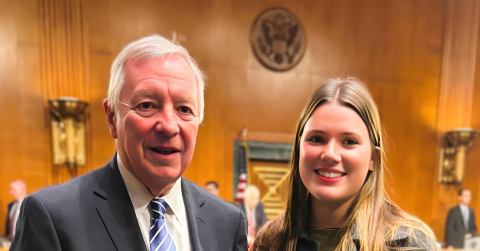You are here
“Hi. My name is Josie. And I’m addicted to nicotine because of e-cigarettes.”
Appearing before a Senate committee on youth vaping in June 2024, 18-year-old college freshman Josie Shapiro testified that she was only 14 years old when she first tasted a blueberry-ice flavored e-cigarette. “It felt like I was eating a piece of candy, and I could keep hitting the vape and keep having this flavor, and it was just so good.”
Josie’s attraction was far from unique, according to Monitoring E-Cigarette Trends in the United States: Urgent Action Needed to Protect Kids from Flavored E-Cigarettes, a report just released by the CDC Foundation and Truth Initiative. Along with colorful and cartoon-like packaging, these types of e-cigarettes attract kids and teens with flavors ranging from fruit, mint, sweets and desserts to energy and alcoholic drinks. In fact, a recent CDC and FDA survey found that almost 88% percent of the more than 1.63 million young people who reported vaping in 2024 said they’d used flavored e-cigarettes.
Flavored E-Cigarette Sales Increase
The report finds a 47 percent increase in e-cigarette unit sales at U.S. retail outlets from 2019 through 2023, with much of this increase coming from disposable e-cigarettes, the device type most favored by young people. Sales of disposable e-cigarettes increased by more than 500 percent during this time.
Many of the latest e-cigarettes are marketed with names that don’t appear to be flavored, like “clear” or “ice.” But these products feature menthol and menthol-like flavoring, known by the industry to provide a cooling sensation that makes them easier for beginning vapers to tolerate. The report notes the sale of e-cigarettes with these types of cooling-flavor names increased 872 percent between 2020 and 2023.
But it’s not just the flavors that make e-cigarettes so addictive to kids and teens. The report mentions that the average nicotine strength of disposable e-cigarettes increased almost 300 percent in the span of five years, with some containing as much nicotine as 20 or more packs of regular cigarettes. This rise in the sales of high-nicotine e-cigarettes coincided with an increase in the percentage of youth who reported using these devices frequently or daily.
Nicotine Cravings Rise
Josie also testified to Congress about her growing addiction. “I thought I was just enjoying the flavors, but soon my brain craved the nicotine more and more.”
She described feeling trapped in a cycle of physically and emotionally painful cravings. “It’s really intense and scary,” Josie said. “It makes you feel completely out of control and helpless. Nicotine gives you this head rush, this buzzing feeling. I was always thinking about when I was going to get my next hit.”
The risks are significant, particularly for young people. “The brain is more susceptible to nicotine addiction during adolescence,” said Rachel Boykan, MD, FAAP of the American Academy of Pediatrics, who is quoted in the report: “Nicotine can have lasting damaging effects on adolescent brain development and nicotine exposure among youth is linked to reduced impulse control, increased risk of attention-deficit/hyperactivity disorder and increased risk for anxiety and depression.”

Sen. Dick Durbin (IL) and Josie Shapiro
Young People Speak Out
Josie is keenly aware that she and other young people have been targeted by product manufacturers and marketers. “I feel like that's how they trap you, like, with the nicotine and the flavors. I wouldn't have kept hitting the vape if it was not blueberry ice.”
“Flavors get them through the door. And when they get through the door with those flavors, nicotine is just going to make them stay,” said Connor Lam, a 17-year-old high school senior from Pleasanton, California. “And I think that's a really sad reality that we're going to have to face, and we're going to have to fight.”
To do so, Josie and Connor are both involved with the Campaign for Tobacco-Free Kids (CTFK), a non-profit dedicated to working to reduce tobacco use and its deadly consequences. Motivated by the negative health impacts of long-term smoking on his beloved grandfather, Connor successfully lobbied his local city council to outlaw flavored e-cigarettes and ban tobacco retailers from selling near schools. For these efforts and others, Connor won the CTFK 2024 Youth Advocate of the Year Award.
Connor Lam, 17, of Pleasanton, California
CTFK 2024 Youth Advocate of the Year Connor Lam
CTFK advocate Connor Lam shares information
State Restrictions Make an Impact
And this work is having an impact. California’s statewide law restricting the sale of flavored tobacco products reduced sales by 68 percent the first year after it went into effect. Similar policies in other states resulted in equally dramatic results, with Massachusetts seeing a decrease in flavored e-cigarette sales of 98 percent, while New York experienced a drop of 79 percent.
Since 2019, the CDC Foundation and its partners—the Centers for Disease Control and Prevention (CDC), Truth Initiative, Campaign for Tobacco-Free Kids and Bloomberg Philanthropies—have been conducting research on the sales of tobacco products and the effectiveness of flavored e-cigarette restriction policies to help find ways to keep kids and teens from accessing these addictive products.
In addition, a new website, TobaccoMonitoring.org, features interactive charts, the latest national and state-by-state sales figures, survey results on e-cigarette use and public health research. The site contains data from 2019 through September 2024 and will be updated as new data are released, providing the most comprehensive and up-to-date information on e-cigarette and tobacco trends.

Read the full report.
Get involved with Campaign for Tobacco-Free Kids.
Get help quitting from Truth Initiative.
Funding provided by the Bloomberg Initiative to Reduce Tobacco Use through the CDC Foundation with a grant from Bloomberg Philanthropies.
